nn
n
n The task of separating fact from fiction is, for menat least, one of the most fascinating elements of studying history. The mostnvaluable evidence comes from what are called ‘primary sources’, which arenartefacts that are contemporaneous with whatever it is that historians arenconsidering. These can be written sources – reports, diaries, letters and so onn– but can also be almost any other things that you may care to imagine, evenndown to the minutiae of everyday life.
n
n
n
nOther things that come from later times,nthings like autobiographies, reconstructions and so on, are called ‘secondarynsources’ and are necessarily, consciously or unconsciously, coloured by theirncreator’s own conceptual filters. That isn’t to say that primary sources arenalways entirely free from bias, and that is where the separation of fact andnfiction enters into the equation.
n
n
n
 |
| Richard III |
n
n
n
nLet’s look at the death of Richard III, as annexample. Richard died at the Battle of Bosworth Field, which happened on Augustn22nd 1485, and there can be no credible doubt about that. Thenchroniclers who wrote about the battle agree that he died in the thick of thenbattle, from wounds inflicted during the fighting. The continuer of the CroylandnChronicle, which is the nearest thing to a contemporary account, has littlento say about the actual battle,
n
n
n
n“For while fighting, and not in the act ofnflight, the said king Richard was pierced with numerous deadly wounds, and fellnin the field like a brave and most valiant prince.”n
n
n
n
n
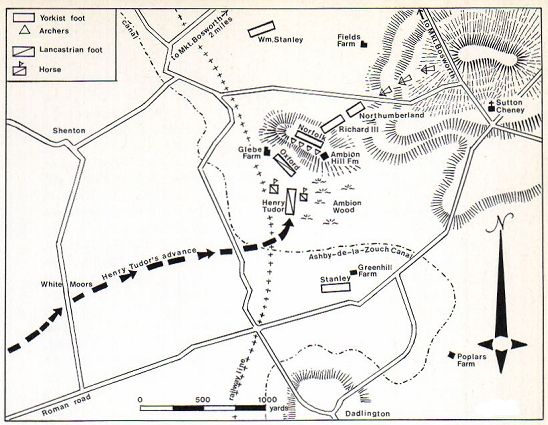 |
| Plan of Battle of Bosworth Field |
n
n
n
nAnother chronicler,nPhilip de Commines, a French diplomat writing a little after the events, isneven briefer,
n
n
n
n“… The Earl of Richmond, the present king … in a set battlendefeated and slew this bloody King Richard,”n
n
n
nand Robert Fabyan, in the NewnChronicle of England is briefer yet,
n
n
n
n“…nere vnto a village innLeycestershyre, named Bosworth … kynge Richarde was there slayne.”n
n
n
nPolydorenVergil, again writing slightly later, yet still in living memory of the battle,nhas,
n
n
n
n“King Richerd alone was killyd fyghting manfully in the thickkestnpresse of his enemyes.”n
n
n
n
n
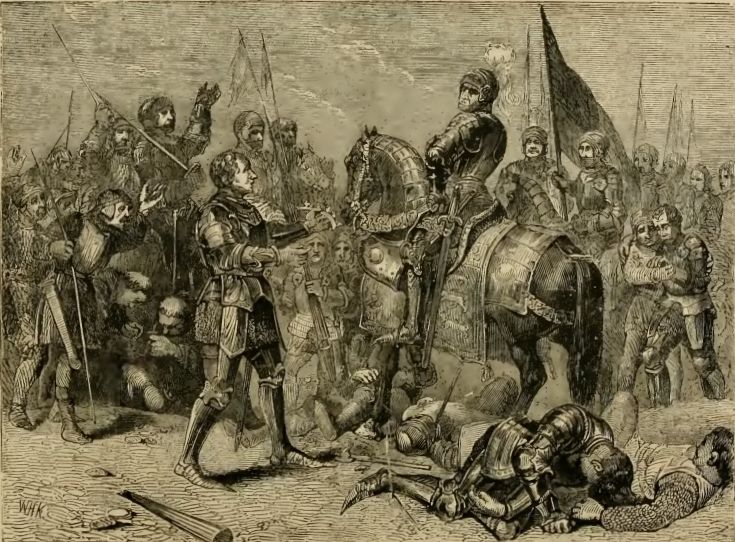 |
| Henry VII offered the crown on Bosworth Field |
n
n
n
nNow it has to be said that Henry VII, victor atnBosworth, had later writers skew events to suit the Tudor interpretation andnwas keen to present Richard in a very bad light but on the other hand, it wasnbetter for his image if he gained the crown by taking it from a formidablenopponent – it reads better if his foe was someone worth besting, rather thannsnatching kingship from a snivelling coward caught hiding in a hole in thenground. However, what is recorded next doesn’t really show Henry as a gracious winner,nas the chroniclers tell what happened to Richard’s corpse. Croylandnsays,
n
n
n
n“… the body of the said king Richard being found among the dead … manynother insults were also heaped upon it, and, not exactly in accordance with thenlaws of humanity, a halter being thrown round the neck, it was carried tonLeicester.”n
n
n
n
n
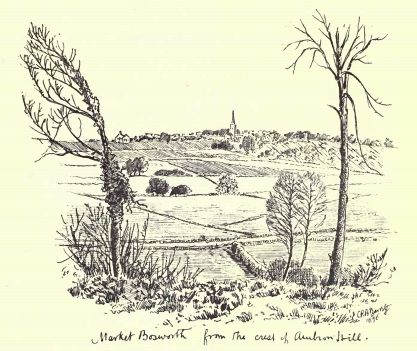 |
| The view toward Market Bosworth |
n
n
n
nFabyan’s account agrees with the despoliation of Richard’snbody,
n
n
n
n“Thanne was the corps of Richarde, late kynge, spoyled, &, naked, as he was borne, castnbehynde a man, and so caryed unreuerently overthwarte the horse backe vnto thenfryers at Leyceter; where after a season that he had lyen, that all men mightnbeholde hym, he was there with lytel reuerence buryed.”n
n
n
nVergil too has ansimilar version of the fate of the former king,
n
n
n
n“In the meane time the bodynof king Rycherd nakyd of all clothing, and layd uponn an horse bake with thenarmes and legges hanginge downe on both sydes, was browght to thabbay of monksnFranciscanes at Leycester, a myserable spectacle in good sooth, but notnunworthy for the mans lyfe, and ther was buryed two days after without anynpompe or solemne funerall.”n
n
n
n
n
 |
| View over Bosworth Field |
n
n
n
nThe Chronicle of the Grey Friars (thatnis, the same Franciscans mentioned above), is maddeningly brief,
n
n
n
n“This yerenin August the erle of Richmond with the erle of Pembroke that long hade benenbanyshed, came into Ynglond, and the other gentylmen that flede into France, [and]nmade a felde besyde Leyceter, and the kynge there slayne.”n
n
n
nSo, it seemsnlikely, Richard III’s body was stripped, a halter put about his neck, and hisnbody thrown over a horse’s back and taken to Leicester where, after it had beenndisplayed publicly, the Franciscans buried it in their church of St Mary’s.nHenry VII raised a marble monument but this was lost during the dissolution ofnthe monasteries made under his son, Henry VIII.
n
n
n
 |
| Epitaph to Richard III – from George Buck – The History of the Life and Reigne of Richard III – 1647 |
n
n
n
nA prominent local citizen,nRobert Heyrick, acquired the land on which the monastery had stood and he had ansmall column built on the site, with a dedication to ‘King Richard III, somentime king of England’, which was described by Sir Christopher Wren in 1612,nbut this too has since been destroyed, and by the days of Charles I, the sitenof the grave had been lost. A local tradition had it that the bones of Richardnhad been taken from the grave and thrown into the River Soar.
n
n
n
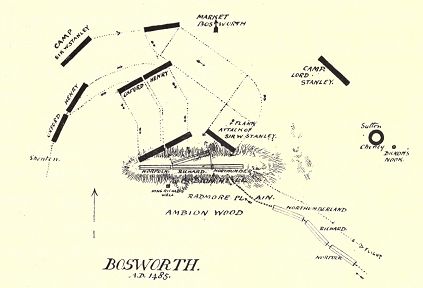 |
| Plan of the Battle of Bosworth |
n
n
n
nThe stone coffinnin which the body had lain was supposed to have been taken to a local inn, thenWhite Horse Inn, and was used as a water trough, but when the historian WilliamnHutton went in search of it, in 1758, locals told him that it had been brokennup and used to build steps in the cellar of the same inn.
n
n
n
 |
| The White Boar, later the Blue Boar, Leicester |
n
n
n
nAnother inn, namednfor Richard’s heraldic device, was the White Boar, where Richard wasnsaid to have spent his last night, but this was renamed the Blue Boarnwhen the Tudors came to power and was eventually demolished in 1836.
n
n
n
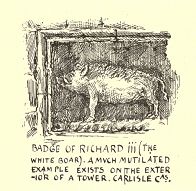 |
| The Badge of Richard III |
n
n
n
nAnd then,nin 2009, Philippa Langley, Secretary of the Scottish Richard III societynlaunched a project to attempt to discover the remains of the only English kingnwhose resting place was unknown. In collaboration with the University of LeicesternArchaeological Services, surveys were made and in 2012, test trenches werenexcavated in the staff car park of Leicester Social Services, where it wasnthought the former monastery of St Mary’s had once stood. The ULAS websitentells the whole story and a remarkable story it is too, I strongly recommendnyou visit it at least once, but suffice to say that a skeleton was found thatnthat, when a battery of various tests had been completed, was declared to be ‘beyondnreasonable doubt’ that of the lost monarch.
n
n
n
 |
| Henry VII crowned at Bosworth |
n
n
n
nThe skull showed evidence ofndamage that could only have been inflicted during mortal combat, confirming thenchroniclers’ reports that Richard had died in battle (and negating the legendnthat his body had been dumped in the Soar). You simply don’t get better primarynevidence than that! As I write this, it is still undecided where the bones willneventually re-interred.
nnn
n
nnn
n


















